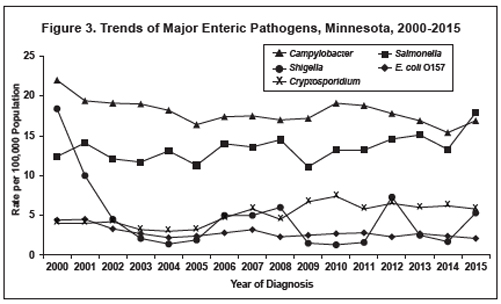Annual Summary of Disease Activity:
Disease Control Newsletter (DCN)
Related Topics
Contact Info
Cryptosporidiosis, 2015
During 2015, 316 cryptosporidiosis cases (5.8 per 100,000 population) were reported (Figure 3). This is similar to the median number of cases reported annually from 2005 to 2014 (median, 316 cases; range, 166 to 389). The median age of cases was 25 years (range, 9 months to 88 years). Children ≤10 years of age accounted for 25% of cases. Fifty-four percent of cases occurred during July through October. The incidence in the West Central, Southwestern, Southeastern, South Central, and Central districts (18.5, 16.9, 12.0, 10.4, and 7.8 cases per 100,000, respectively) was significantly higher than the statewide incidence. Only 72 (23%) cases occurred among residents of the metropolitan area (2.4 per 100,000). Twenty-nine (9%) cases required hospitalization, for a median of 4 days (range, 2 to 22 days).
Ten outbreaks were identified in 2015, accounting for 16 laboratoryconfirmed cases. Three outbreaks were associated with contact with calves, accounting for 26 cases (5 laboratoryconfirmed). These outbreaks were associated with a private farm (Swift County), an animal research facility (Anoka County), and a veterinary technician class farm visit (Hennepin County). Seven outbreaks due to person-to-person transmission at daycares or preschools accounted for 37 cases (11 laboratory-confirmed); the outbreaks occurred in Blue Earth, Clay, Dakota, Mower, Nicollet, Nobles, and Pope Counties.
In a 2010 paper published in Clinical Infectious Diseases, we evaluated rapid assays used by Minnesota clinical laboratories for the diagnosis of cryptosporidiosis. The positive predictive value of the rapid assays was 56%, compared to 97% for non-rapid assays, suggesting the widespread use of rapid assays could be artificially contributing to the increased number of reported cases of cryptosporidiosis. In 2015, 239 (76%) patients were positive for Cryptosporidium by a rapid assay conducted in a clinical laboratory. However, 50 (24%) of the 205 specimens received at the PHL could not subsequently be confirmed by polymerase chain reaction or direct fluorescent antibody test. Rapid assay-positive specimens should be confirmed with other methods. It is important that health care providers are aware of the limitations and proper use of rapid assays in the diagnosis of cryptosporidiosis and that they limit testing to patients who have symptoms characteristic of the disease.

- For up to date information see>> Cryptosporidiosis (Cryptosporidium spp.)
- Full issue>> Annual Summary of Communicable Diseases Reported to the Minnesota Department of Health, 2015